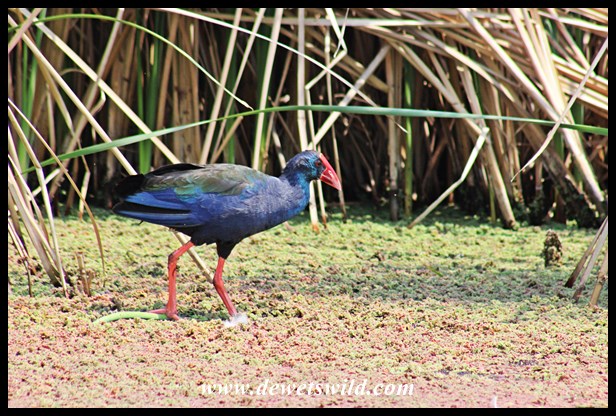Porphyrio madagascariensis
The African Swamphen is a shy, skulking inhabitant of dense reedbeds along slow flowing rivers, marshes, swamps and temporary wetlands where they feed mainly on aquatic plants, insects and other invertebrates, fish, frogs and eggs. They are usually seen singly but may be encountered in small family groups from time to time. African Swamphens breed at any time of year, though there is a distinct peak in the summer months. Their nests are large and built of and among reeds. Clutches contain between 2 and 5 eggs, are incubated by both parents and hatch after about 3 weeks. Both parents care for the chicks, which fledge at about two months old.
Adults are around 42cm long, weigh approximately 600g and are by far the biggest members of the rail family occurring in South Africa.
In South Africa, the African Swamphen, or Purple Gallinule as it was previously known, is distributed very patchily on the highveld and along the eastern and southern coastlines. Some authorities consider the African Swamphen to be a subspecies of the Purple Swamphen (P. porphyrio) which has a wide distribution over Africa, Europe, Asia and Australia), and is listed as being of least concern by the IUCN.

















Look like our moorhens… on steroids! 😉
LikeLiked by 1 person
That’s a very good and accurate description, AJ!
LikeLike
Now after hours and days of thinking I remind the name the bird look like, the moorhen! (common moorhen) Well, I haven’t been sleepless but I have thought about the name so much. I have shoot it couple of times and it’s quite common here. When I got something in my head I have hard to let it go!😁😁😁
LikeLiked by 2 people
Indeed John, the build is very similar and they are both in the same family. We also have the common moorhen here in South Africa, and it is much smaller than this Swamphen
LikeLiked by 1 person
Dit is skokkend droog in die wildtuin, de Wet. Ek en Bertus kan nie glo wat ons oë sien nie. Waar is die seekoeie en krokodille heen? Die water is amper alles weg. Ons sien wel honderde koedoes en zebras, baie klipspringers, steenbokkies, gompoue en selfs ń vaalboskat, maar bitter min olifante.
LikeLike
November is ongelukkig die droogste deel van die jaar in die Laeveld – nou is die veld oop en kaal en mens sien baie diere wat jy nie gewoonlik sal sien nie, soos vaalboskatte!, en partykeer voel dit of elke watergat n trop leeus het wat wag om die dorstige troppe wild aan te val.
Die olifante behoort nou langs die oorblywende waterbronne gekonsentreer te wees – riviere soos die Shingwedzi en Letaba in die mopanieveld van die Noorde is nou die plek om vir hulle in hul hordes uit te kyk.
Die seekoeie het sleg deurgeloop in die droogte van so 2-4 jaar terug en hul bevolkings het nog nie herstel nie.
Julle moet tog weer hier in Maart of April gaan kyk hoe die veld geil staan teen die einde van die reenseisoen – ek hoop ons het n goeie een!
LikeLike
Dankie vir die inligting!🤗
LikeLiked by 1 person
Such a colorful outfit he’s wearing. 😃
LikeLiked by 1 person
Going for the “best dressed” award!
LikeLiked by 1 person
He has some stiff competition from my Mr. GBH and also Iggy😃
LikeLiked by 1 person
And I’d imagine they won’t give up their titles without a fight!
LikeLiked by 1 person
That would be worth watching. 😅 We’d better referee the fight fairly. Don’t want anyone getting hurt. 😳
LikeLiked by 1 person
It will be a tough one for the bookies to call!
LikeLiked by 1 person
Dit is vir seker. 🙄
LikeLiked by 1 person
For a minute there I was muttering ‘Swumfen? Swumfen?’ Then I took a hard ‘P’ — no, not that way! 🙂
Striking colour in legs and beak.
LikeLiked by 1 person
I bet the guys and girls who changed its name from Gallinule never thought about the confusion the “ph” could lead to! 😀 😀 😀
LikeLiked by 1 person
‘Gallinule’ certainly did not lend itself to quite the same confusion!
LikeLiked by 1 person
Lovely to see your pics of such a reclusive bird, and it is so breathtakingly colourful.
LikeLiked by 1 person
Amazing that such a shy species is so colourful – one would expect it to be very cryptically coloured.
LikeLike
Dis darem ‘n pragtige voël, Dries. Ek stem saam dat die Engelse naam nie mooi is nie. Dis verwarrend, want dit klink of al die voëls vroulik is! Lieflike foto’s!
LikeLiked by 1 person
Hulle is regtig besonders mooi vir n voel wat so lief is om weg te kruip!
LikeLiked by 1 person
Gallinule is a more elegant epithet than swamphen! The latter is undignified for such an attractive bird.
LikeLiked by 3 people
I agree wholeheartedly, Anne!
LikeLike
Fancy red beak and matching legs. Pretty cool.
janet
LikeLiked by 1 person
Pity they’re so shy to show off!
LikeLiked by 1 person
I would imagine that choosing to live in that habitat is a very successful strategy for them.
LikeLiked by 1 person
I’d agree – even here in Africa there’s few predators that are able to hunt in the environment favoured by the swamphen.
LikeLiked by 1 person
Isn’t it gorgeous! I just love the fluffy white bottom and red/purple combo. I got a couple of nice photos the other day of the purple swamphen. They seem much less shy at this time of the year as they go about their business.
LikeLiked by 1 person
I would love to see a few photos for comparison, Tracy!
LikeLiked by 1 person
I’ve posted a few, Dries. 🙂
LikeLiked by 1 person
I’m going to have a look straight away!
LikeLiked by 1 person